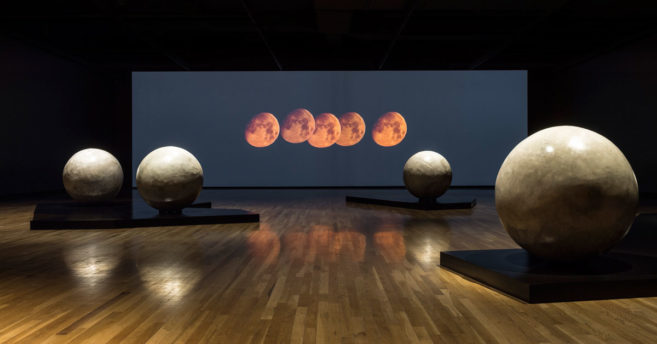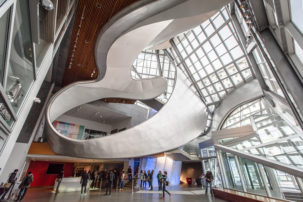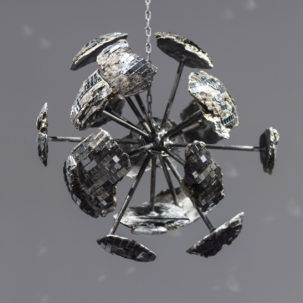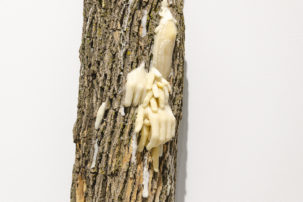“There is much to do in this world, but are biennials a good start?” asks Lorenzo Fusi in his opening essay for the current Alberta Biennial catalogue. It’s a meaty question that strikes at the existential core of contemporary art’s responsiveness to everyday life. Consider, for instance, the seismic shifts between early 2015, when biennial curators Peta Rake and Kristy Trinier began their research, and summer 2017 when the exhibition opened in Edmonton and Banff: Forty years of Conservative rule in Alberta came to an end. The final recommendations of the Truth and Reconciliation Commission were released. The Fort McMurray wildfire, Canada’s most expensive national disaster to date, compounded the struggles of an already troubled oil industry. Amid a broader turn toward neo-fascism and reactionary politics, Fusi’s inquiry is a tenable one.
So how do we respond? Where international biennials often purport to capture how politics filter into aesthetics, to prove art’s relevance at times of crisis, regional biennials tend to map an underrepresented artistic ecosystem in a “best-of” fashion. The tenth iteration of the Alberta Biennial, “For the Time Being,” doesn’t attempt either; instead it assembles 24 artists at the Art Gallery of Alberta and the Banff Centre’s Walter Phillips Gallery to put forth an open-ended response.
Co-curators Rake and Trinier logged more than 4,500 kilometres in researching the exhibition—from suburbs to industrial centres, and cities to rural sites—including studio visits to as many as 75 artists who responded to the biennial’s open call.
“We’re not trying to describe all of contemporary art in Alberta. We can only describe what we know, which is shifting daily, of the 24 practices that we’ve engaged with at this particular two-year period,” the co-curators concur.
In biennials of all scales and scopes, the curators tend to dictate the direction with a singular vision, but here Rake and Trinier attempted to put the artists’ discourses and desires front and centre. For the first time, the biennial artists were assembled for a four-day residency at the Banff Centre—the Banff Biennial sessions—last summer. There the curators deliberated with the artists and residency guest curators Lorenzo Fusi and Kendal Henry over what the biennial model could be and who it ought to serve. Then the curators asked the artists to imagine a project they’ve never had the opportunity to make.
“Bringing the artists together to have conversations about why we are making a biennial was, for me, a very important conversation to have because I think the biennial format is fraught and flawed,” Rake told me. “‘Who is a biennial for?’ frames our methodology of ‘conversation’ as a structure. If it isn’t first and foremost for the artists, then something is askew.”
“We were trying to answer, ‘What is the purpose of a biennial?’ through this iteration, because a biennial is a way to look at a place, a framework and a time,” Trinier said.
Since the Alberta Biennial’s inception in 1996, the selection criteria dictated that the artists lived and worked in Alberta. This year, the co-curators wanted to resist that tendency to see regionalism through rose-coloured glasses—“Because that idea of belonging to a site is outdated,” Rake said—and to expand the idea of who can contribute to a regional biennial. In “For the Time Being,” not all artists were born in Alberta or currently live there, but they still maintain some connection to it. “We’re thinking about diasporas of Alberta, in a sense,” Rake said.
“There’s nothing that unifies them, because they’re geographically, economically and politically so disparate,” said Trinier. When Trinier curated the 2015 Alberta Biennial, she made more of an explicit attempt to foreground neglected homegrown art practices that spoke to austerity, detritus and natural forces. Artists working in Alberta have to create their own context in isolation— “which isn’t easy; it’s foolhardy,” said Trinier—relative to Toronto or Vancouver.
“There’s something about being on an edge out here that people articulated to us,” Trinier added, “that they sometimes felt that they were doing their own thing and no one’s paying attention.”
Of course there are no quintessential attributes to art made by people with affiliations to Alberta—whether by birth, upbringing or practice—but many of the works in both biennial locations are very much site-specific in their invocation of longing, absence, prairie landscape or family history.
You need to traverse the length of the Walter Phillips Gallery’s satellite space to read Mark Clintberg’s ceiling installation DO I STILL CROSS YOUR MIND (2017). The glow from the work’s LED tube lights is so pervasive that the reflection of the words they spell out is the only thing the space’s windows allow you to see in them. The fluorescent light is contained by a grey concrete ceiling and grey carpeting, almost isolating the installation from the woods immediately outside the gallery’s windows and the mountains in the distance. Approaching the windows reveals a series of metal serving trays arranged along the gallery’s exterior—a reference to the museological convention of providing mirrored trays to assist with viewing ceiling artworks—reflecting yourself to you in the trees, reminding you of where you are. Until then, the room feels frigid. DO I STILL CROSS YOUR MIND almost voices a plea, but the absence of a question mark suggests that imagined voice’s indifference.
Justin Waddell’s Float in Space and Drift in Time (2017) similarly plays with light and confining reflections of landscape. Small hand-carved, peak-like soapstone sculptures float atop a mirrored platform. Varying gradients of balmy light flicker from a hand-processed 16mm film that projects close-ups of the peaks, abstracting their scale, while a droning soundtrack washes over the room. The mirrored platform sets up an entrancing infinite loop: of the soundtrack, composed of electric-guitar feedback and field recordings; and the reflections and projection of the stone carvings of the peaks, which Waddell based on similar ones that his grandparents acquired or made themselves while in the Japanese-Canadian internment camps in BC during the the Second World War. Waddell’s attempt to evoke the infiniteness of mountainous landscape is just as elusive to a cellphone camera as the landscape itself.
Terrain gets hemmed in again, but within a picture plane, in Wil Murray’s THE ONLYES POWER IS NO POWER: Ituna To Athabasca (2017). Murray’s family operated a novelty circus in Humboldt, Saskatchewan, from 1932 to 1943. Advertised as “the biggest and best travelling show, with 100 per cent of viewers being satisfied,” it boasted a dancing dog, a singing cowboy and a 650-pound roller-skating bear named George. Just six months after the Second World War, travel restrictions forced the circus to disband, and incendiary Japanese “Fu-Go” balloon bombs hit the very same sites that hosted the circus. To make the five shaped panels, Murray shot double exposures of ten of those sites, once in the summer, and again in the winter, then painted atop the negatives. His broad brush strokes are so dynamic that they almost obscure that landscape, but the stark slivers of it that he reveals speak to his family’s narrow escape.
Spelling out absence recurs in Nicole Kelly Westman’s installation if you weren’t there (2017). A film projects the title words—handwritten, blinking, repeating, fading, focusing, blurring, oscillating between red and blue. The solemn, ambient droning audio brings home the absence of the “you” addressed here. A hand-bound printed text, a year of obituaries, details the artist’s mourning of the loss of two family members at different times in her life; its reverse side bears this inscription:
“for Louise
you are a
guiding light
I wish to emulate
you are the
strongest woman
I know”
Caught in the wistful space, I imagined the inscription scrawled each time in the edition of 50, deteriorating to the point of becoming hollow syllabics void of the designated sentiment. The red and magenta spotlight overhead modernist armchairs highlight their emptiness, until you fill a chair yourself.
Tamara Lee-Anne Cardinal’s Akohp: A Blanket (2016) levitates in a neighbouring gallery. Standing under the sprawling, translucent, hand-stitched, seven-point-star blanket, light reveals faint trails of the artist’s hair in the paper she made, incorporating sacred medicines she’s received as gifts or that have been harvested by her family, such as tobacco, sweetgrass, sage, wîhkês and red cedar. Cardinal’s family narratives, the seven sacred teachings, seven directions and medicine women’s teachings inform the piece’s form and content.
“I was working out ideas about what the Truth and Reconciliation Commission means, to myself and my family, and how it affects our future generations and hearing those stories from our elders about residential schools,” Cardinal says about the origins of the piece, which initially incorporated legible prints of the TRC report. “Only a portion of the truth has been heard.” The seven-pointed star signifies above, below and within. Though there’s no legible text from the TRC in the piece—a testament to Cardinal’s interest in “steering away from the colonial structure of written policy”—when you stand under Akohp: A Blanket, and you activate the work, you can’t escape the document’s weight.
A few artists attempt to hint at Alberta’s troubled economic state.
Kristopher Karklin shows us a nude, hand-holding couple from behind as they covet a cookie-cutter suburban home. Home’s (2017) starkness renders the figures inert, suggesting that their desire is just beyond their reach. Karklin’s manipulation of the symmetrical image distorts the two homes on either side of the one they’re looking at, and drags the buildings to the edges of the picture frame, enclosing the couple and immobilizing them. The claustrophobia it rouses is chilling.
In What exactly were we supposed to have learned from the fire? (2016), Megan Green drapes a rope that frays between the wall it’s nailed to and the ground, where it ties to a deer leg that the artist found on a Fort McMurray driveway. The nest-like fray almost snaps the rope, and the two sides hang to each other by a thread, literally, hovering over a black candle placed on the ground. The didactic says that the work “re-conceptualizes the ram-shackled plastic impermanence of the supposed landscape of ‘trailers and McMansions’ where the leg was found as spaces of new encounters with an affective geo-cultural landscape,” but it feels like a stretch.
Interrogating the relevance of the biennial model is ever more pertinent now. Recently, the 2018 Biennale de Montréal was cancelled due to financial deficits. In their opening remarks at the opening, Rake and Trinier questioned whether there would be another Alberta Biennial. Whether they’re regional or international, biennials declare something, and the pressure to do so is directly proportional to how high the stakes are. But “For the Time Being”’s evasiveness of definitive declaration unaffectedly puts forth work produced during a fraught time and in a fleeting place.
The Alberta Biennial is on view at the Art Gallery of Alberta in Edmonton and at the Walter Phillips Gallery in Banff till September 10.









